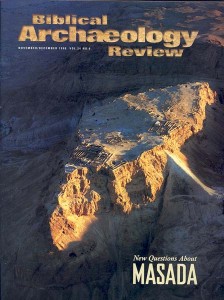Where Masada’s Defenders Fell
A garbled passage in Josephus has obscured the location of the mass suicide

Prior to Yigael Yadin’s excavations in the 1960s, most of what we knew about Herod the Great’s mountain fortress of Masada came from the first-century C.E. Jewish historian Flavius Josephus. The story is well known: After the Romans destroyed Jerusalem and burned the Temple in 70 C.E., the First Jewish Revolt against Rome was, for all practical purposes, suppressed. However, three fortresses in the Judean wilderness remained outside Roman control: Herodium, Machaerus and Masada. It took the Roman military machine a number of years to attend to these remnants of the revolt. Masada, occupied by 967 Jewish rebels, was the last fortress the Romans attacked. They built numerous camps around the site, amassed thousands of troops, besieged it for three to four years, and, finally, built a ramp and stormed the fortress proper. Yet when the Romans, led by Silva, breached Masada’s walls, they encountered only silence: 960 of the Jews had committed suicide rather than surrender to their enemies.
Already a library member? Log in here.
Institution user? Log in with your IP address.

